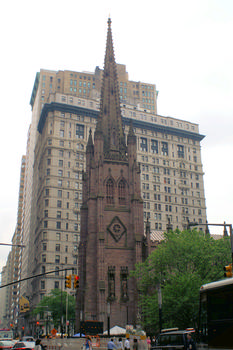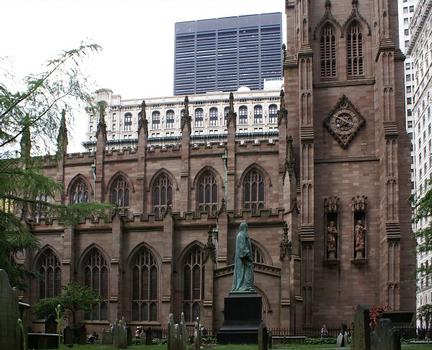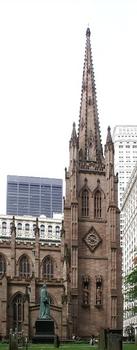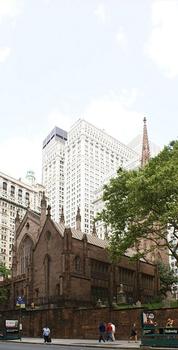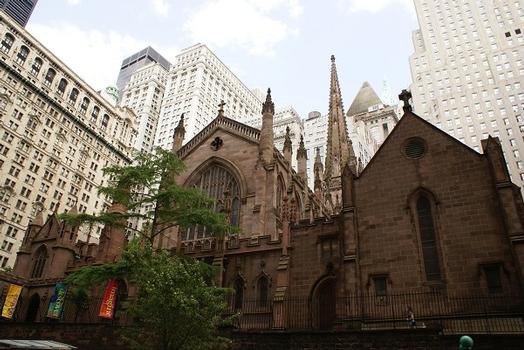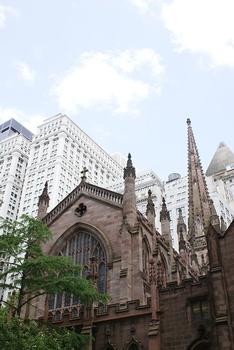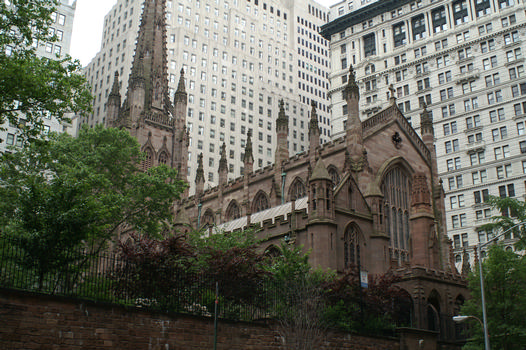General Information
Project Type
| Structure: |
Rib vault |
|---|---|
| Function / usage: |
Church |
| Architectural style: |
Neo-Gothic |
Awards and Distinctions
| 1976 |
for registered users for registered users |
|---|---|
| 1966 |
Location
| Location: |
Manhattan, New York, New York, USA |
|---|---|
| Address: | 79 Broadway |
| Connects to: |
Trinity Place Bridge (1987)
|
| Coordinates: | 40° 42' 29.02" N 74° 0' 43.90" W |
Technical Information
Materials
| piers |
stone
|
|---|---|
| columns |
stone
|
Excerpt from Wikipedia
Trinity Church is a historic parish church in the Episcopal Diocese of New York, at the intersection of Wall Street and Broadway in the Financial District of Lower Manhattan in New York City. Known for its history, location, architecture and endowment, Trinity is a traditional high church, with an active parish centered around the Episcopal Church and the worldwide Anglican Communion in missionary, outreach, and fellowship. In addition to its main facility, Trinity operates two chapels: St. Paul's Chapel, and the Chapel of St. Cornelius the Centurion on Governors Island. The Church of the Intercession, the Trinity Chapel Complex and many other of Anglican congregations in Manhattan were part of Trinity at one point. Columbia University was founded on the church's grounds as King's College in 1754.
The current building is the third constructed for Trinity Church, and was designed by Richard Upjohn in the Gothic Revival style. The first Trinity Church building was a single-story rectangular structure facing the Hudson River, which was constructed in 1698 and destroyed in the Great New York City Fire of 1776. The second Trinity Church was built facing Wall Street and was consecrated in 1790. The current church building was erected from 1839 to 1846 and was the tallest building in the United States until 1869, as well as the tallest in New York City until 1890. In 1876–1877 a reredos and altar were erected in memory of William Backhouse Astor Sr., to the designs of architect Frederick Clarke Withers, who extended the rear.
The church building is adjacent to the Trinity Churchyard, one of three used by the church. Besides its building, Trinity manages real estate properties with a combined worth of over $6 billion as of 2019. Trinity's main building is a National Historic Landmark as well as a New York City designated landmark. It is also a contributing property to the Wall Street Historic District, a NRHP district created in 2007.
History
In 1696, Governor Benjamin Fletcher approved the purchase of land in Lower Manhattan by the Church of England community for construction of a new church. The parish received its charter from King William III on May 6, 1697. Its land grant specified an annual rent of 60 bushels of wheat. The first rector was William Vesey (for whom nearby Vesey Street is named), a protege of Increase Mather, who served for 49 years until his death in 1746.
First Trinity Church
The first Trinity Church building, a modest rectangular structure with a gambrel roof and small porch, was constructed in 1698, on Wall Street, facing the Hudson River. The land on which it was built was formerly a formal garden and then a burial ground. It was built because in 1696, members of the Church of England (Anglicans) protested to obtain a "charter granting the church legal status" in New York City. According to historical records, Captain William Kidd lent the runner and tackle from his ship for hoisting the stones.
Anne, Queen of Great Britain, increased the parish's land holdings to 215 acres (870,000 m²) in 1705. Later, in 1709, William Huddleston founded Trinity School as the Charity School of the church, and classes were originally held in the steeple of the church. In 1754, King's College (now Columbia University) was chartered by King George II of Great Britain, and instruction began with eight students in a school building near the church.
During the American Revolutionary War the city became the British military and political base of operations in North America, following the departure of General George Washington and the Continental Army shortly after Battle of Long Island and subsequent local defeats. Under British occupation clergy were required to be Loyalists, while the parishioners included some members of the revolutionary New York Provincial Congress, as well as the First and Second Continental Congresses.
The church was destroyed in the Great New York City Fire of 1776, which started in the Fighting Cocks Tavern, destroying between 400 and 500 buildings and houses, and leaving thousands of New Yorkers homeless. Six days later, most of the city's volunteer firemen followed General Washington north. Rev. Charles Inglis served throughout the war and then to Nova Scotia on evacuation with the whole congregation of Trinity Church.
The Rev. Samuel Provoost was appointed Rector of Trinity (1784–1800) in 1784, and the New York State Legislature ratified the charter of Trinity Church, deleting the provision that asserted its loyalty to the King of England. Whig patriots were appointed as vestrymen. In 1787, Provoost was consecrated as the first Bishop of the newly formed Diocese of New York. Following his 1789 inauguration at Federal Hall, George Washington attended Thanksgiving service, presided over by Bishop Provoost, at St. Paul's Chapel, a chapel of the Parish of Trinity Church. He continued to attend services there until the second Trinity Church was finished in 1790. St. Paul's Chapel is currently part of the Parish of Trinity Church and is the oldest public building in continuous use in New York City.
Second Trinity Church
Construction on the second Trinity Church building began in 1788; it was consecrated in 1790. St. Paul's Chapel was used while the second Trinity Church was being built.
The second Trinity Church was built facing Wall Street; it was 200 feet tall, and longer and wider than its predecessor. Building a bigger church was beneficial because the population of New York City was expanding. The church was torn down after being weakened by severe snows during the winter of 1838–39.
The second Trinity Church was politically significant because President Washington and members of his government often worshiped there. Additional notable parishioners included John Jay and Alexander Hamilton.
Third Trinity Church
The third and current Trinity Church began construction in 1839 and was finished in 1846. When the Episcopal Bishop of New York consecrated Trinity Church on Ascension Day (May 1) 1846, its soaring Gothic Revival spire, surmounted by a gilded cross, dominated the skyline of lower Manhattan. Trinity was a welcoming beacon for ships sailing into New York Harbor.
In 1843, Trinity Church's expanding parish was divided due to the burgeoning cityscape and to better serve the needs of its parishioners. The newly formed parish would build Grace Church, to the north on Broadway at 10th street, while the original parish would re-build Trinity Church, the structure that stands today. Both Grace and Trinity Churches were completed and consecrated in 1846.
Trinity Church held the title of tallest building in the United States until 1869, when it was surpassed by St. Michael's Church, Old Town, Chicago. Trinity continued to be the tallest in New York City, with its 281-foot (86 m) spire and cross, until it was surpassed in 1890 by the New York World Building.
In 1876–1877, a reredos and altar were erected in memory of William Backhouse Astor, Sr., to the designs of architect Frederick Clarke Withers. As the chancel was rearranged, the vestry voted for a one-story rear extension with rooms for the clergy, choir, and a mortuary chapel.
On July 9, 1976, Queen Elizabeth II and Prince Philip, Duke of Edinburgh, visited Trinity Church. Vestrymen presented the Queen with a symbolic "back rent" of 279 peppercorns.
21st century events
During the September 11 attacks, people took refuge inside the church from the massive debris cloud produced by the first World Trade Center tower collapse. Some of the chapel pew's paint was rubbed off from the people taking refuge. The pews were later replaced, but one still exists at the back of the chapel for remembrance of the events on 9/11. Falling wreckage knocked over a giant sycamore tree that had stood for nearly a century in the churchyard of St. Paul's Chapel, part of Trinity Church's parish, located several blocks north of Trinity Church. Sculptor Steve Tobin used its roots as the base for a bronze sculpture titled Trinity Root, which stood in front of the church at the corner of Wall Street and Broadway until December 2015, when it was moved by the church to its conference center in Connecticut. The move was controversial as it damaged the sculpture, which was later repaired, and the artist objected to its relocation.
Trinity is located near Zuccotti Park, the location of the Occupy Wall Street protests. It offered both moral and practical support to the demonstrators but balked when protesters demanded an encampment on church-owned land called LentSpace, adjoining Juan Pablo Duarte Square in the neighborhood of Hudson Square. The church hierarchy were criticized by others within the Anglican movement, most notably Archbishop Desmond Tutu. On December 17, 2011, occupiers and a few clergy attempted to occupy LentSpace, which is surrounded by a chain-link fence. After demonstrating in Duarte Park and marching on the streets surrounding the park, occupiers climbed over and under the fence. Police responded by arresting about 50 demonstrators, including at least three Episcopal clergymen and a Roman Catholic nun.
Architecture
Architectural historians consider the third and present Trinity Church building, built in 1846 and designed by architect Richard Upjohn, the first and finest example of Gothic Revival architecture. In 1976, the United States Department of the Interior designated Trinity Church a National Historic Landmark because of its architectural significance and its place within the history of New York City.
Text imported from Wikipedia article "Trinity Church (Manhattan)" and modified on February 10, 2023 according to the CC-BY-SA 4.0 International license.
Participants
- Richard Upjohn (architect)
Relevant Web Sites
Relevant Publications
- (1990): Interessantes Arbeitsgerüst für die Trinity Church in New York. In: Stahlbau, v. 59, n. 5 (May 1990), pp. 157.
- : New York - 25 Bauwerke die man sehen muss. Heike Werner Verlag, Munich (Germany), ISBN 978-3-9809471-2-1, pp. 20-25.
- (1999): New York Landmarks. A Collection of Architectural and Historical Details. Dove Tail Books, pp. 10-11.
- Renforcement des fondations de l'église de la Trinité à New York. In: Ossature métallique, v. 6 (January 1937), pp. 15-18.
- About this
data sheet - Structure-ID
20001196 - Published on:
24/01/2001 - Last updated on:
24/06/2022

